



| <-- Previous | LMHS Home | Contents | Order Book | Next --> |
Gladwyne, Lower Merion’s first town, evolved at the intersection of the roads now called Youngsford and Righters Mill. It is still a quiet, walkable country village, until 1890 known as Merion Square. Mill Creek flows through Gladwyne; most of the many mills have vanished or are in ruins. By 1880, the village had 35 houses, a few stores, and 207 inhabitants. Area residents depended on a stage that operated from Gladwyne to Ardmore, or on the Philadelphia & Reading Railroad which had a station, Rose Glen, near the banks of the Schuylkill River. The Merion Square Hotel (now the Old Guard House Inn) was built on land that was once part of a 250-acre tract of Welshman Richard Walter. It was built in three stages, the earliest dates from about 1810-1817, completely surrounded by farm land. Although there is no evidence that the building was in existence earlier, there is a legend that during the Revolution colonial troops stopped there to quench their thirst.
The hotel’s next proprietor was Thomas Haley, Johnson’s son-in-law, who ran the establishment for some years.
The Merion Square settlement, in early years, became known as War Office because John Rawlins, a captain of a volunteer rifle company, recruited soldiers there for the War of 1812. Years before, John Young, a prominent landowner, was appointed by the Pennsylvania War Office to confiscate flour and other supplies in the area during the Revolution. Later, as the hamlet grew, a new owner, David N. Egbert, changed the village name to the less bellicose Merion Square. Egbert’s store later became Cornman’s, then a hardware store. Gladwyne is a contrived name and was probably first used by the Reading Railroad for its stop at Mill Creek to avoid confusion with other Merions in the township.

The Merion Square Hotel in an 1896 photo. The inn’s owner, Jesse Johnson, is standing to the right of the corner post with his family.
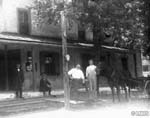
Haley is to the right of the post with Merrill Haggerty, who is handling the horse and buggy. The hand pump may be seen today on the Youngsford Road side near the entrance.

Haley’s son, Roy and the boy’s pet goat. The inn was encircled by farms with cows, horses and domestic fowl.
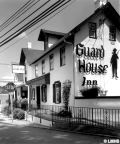
The charming Old Guard House has enjoyed a fine reputation as a gourmet restaurant for over 20 years.

The commercial building and residence (1913 photo) opposite the Guard House was built in1798 (date stone at east end of building) by Henry Hemboldt. The next owner, in 1802, was Harmon Yerkes who added a store.
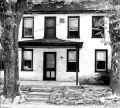
The east end was once known as the War Office, the Saturday night center in the 19th century for discussions by mill workers. David Egbert, also a storekeeper, bought the property in 1822 and the family ran it for 60 years. It also served as the village post office from 1850-1898.

John Breen’s General Store in 1895, once known as Davis’ in the heart of the village. The building, after more than a century, looks the same except for the absence of a porch. It houses the Delaware Market, a gourmet grocery catering to the carriage trade.

Once nicknamed Tammany Hall because of meetings of Democrats at the butcher shop, this small house next to the Gladwyne Free Library had also been a grocery store and tea room. It is now an attractive private home.
"Hap" Arnold (1886-1950) was born on a farm in Gladwyne in 1886. His parents were Mennonites, stern authority figures, who imbued their children with "hard work, no play." A serious child, "Hap" had a permanent grin...hence, "Hap." Shortly after the boy was born, his family moved to Ardmore. Dr. Arnold sold the family home to the Barkers.
Educated locally, he participated in sports and graduated from Lower Merion High School in 1903.
When brother Tom refused his father’s edict to attend West Point, "Hap" took the order and found life delightfully liberating there and gained a major reputation as a prankster.
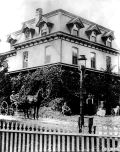
Arnold’s birthplace, on the corner of Youngsford and Conshocken State Roads in Gladwyne, c. 1902 photo. It now serves as the rectory of St. John Vianney Catholic Church.
Since his high school days, "Hap" was interested in the experimental flights of the Wright Brothers. His ambition was to be in the cavalry, but he was assigned to the infantry. There were several mapping assignments in the Phillipines. On one trip he was billeted next to George Marshall, which proved important to both men during World War II.
Deciding that flying was the way out of the infantry, "Hap" enrolled in an exciting new flight training program offered by the Army Signal Corps. The instructors: Wilbur and Orville Wright! In 1912, he was almost killed in a dangerous tail spin which so shattered his nerves that he did not fly again for four years. Major Billy Mitchell, the aviation visionary, encouraged "Hap" back into flying.
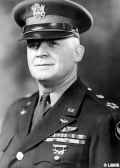
1945 formal photo; five stars. Note Military Aviator Badge on his pocket... only about a dozen were ever awarded. Arnold’s grandson, Robert, recalls: "He never wore all the medals he had...they would have gone from his shoulder on down!" "Hap" is regarded as the father of the United States Air Force.
When home on a leave, his sister introduced him to a local girl, Eleanor (Bea) Pool. He shyly pursued her, as did dozens of other Ardmore boys. Bea and "Hap" wed on September 10, 1912.
When the United States joined the war in 1917, "Hap," to his chagrin, was assigned to Washington, D.C. Though unhappy at not being on combat duty, he made great contacts, learned about mobilization...all of which served him well later in his celebrated career.
By 1938, he was Chief of the Air Corps and struggled to bring that branch into the first rank. He lobbied for increased aircraft production, more air bases and improved pilot training. After the U.S. entered the war in 1941, "Hap’s" vision led to victories in Europe (he insisted on daylight bombings to hit German supply depots) and Japan (initiating fire storms across that country). He foresaw the future of rockets in conflicts and worked with the scientific community and industry in their early explorations.
Victory took its toll...three heart attacks. "Hap" retired in 1946, wrote three books, (including his 1949 autobiography, Global Mission) and visited Lower Merion in 1947. He died a few years later. One of only nine men ever to achieve 5-star rank, "Hap" was a hero here...and a hero to his nation.
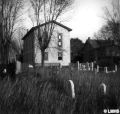
The Gladwyne Methodist Church (1913 photo), originally the Merion Square Methodist Episcopal Church, on Righters Mill Road, dates from 1838 when it was organized. The first part, now the Sunday School, was built in 1840, rebuilt in 1865-66 and improved between 1943-1950. An addition was completed in 1961.
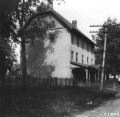
Next door is the Independent Order of Odd Fellows (1912 photo), constructed in 1852. Its cemetery, behind the building, blends into the cemetery of the Methodist Church and contains the graves of many of Merion Square’s (Gladwyne) first residents.

After the Civil War, the small clapboard building was erected to be both the post office and home of the wounded veteran, William Snell, who became the postmaster of Merion Square, the only post office in Lower Merion. During those years it was used for storage for the hardware store next door; then a barber shop. Now the Gladwyne Lunch, a popular place for breakfast and midday meals, it is one of the few restaurants in the township where outdoor eating is permitted.

The solid stone building built in 1921 by All Saints Episcopal Church, was the Gladwyne Community Hall with a basketball court, a stage and, at one time, was the post office. One room was for Maud Bell’s books that evolved into the Gladwyne Free Library by 1930. The modern addition and glassed exterior stairwell were added in the 1960s and the building was completely renovated in1992. The Community Room is the setting for meetings ranging from the Civic Association, Story Hour for youngsters, and the Library League’s annual Craft Show. The library is the "Heart of the Village."

A walk through the Gladwyne (Merion Square) Historic District, established in 1980, reveals an amazing variety of residences: converted mill workers’ houses; simple homes with Victorian, Stick Style and Gothic Revival embellishments; cottages and double houses from the 1920s; small, elegant estates.

The charming home was likely a section of a state pavilion removed from Fairmount Park at the end of the Philadelphia Centennial.
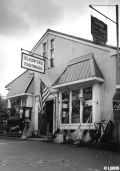
Stores have a smalltown look and pride themselves on their friendly service. In two short blocks one finds: a gas station; two banks; a big supermarket and several small groceries; drug store; dry cleaner; florist; veterinarian; real estate agencies; and other specialty businesses.
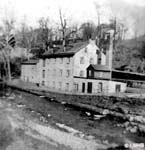
Merion Mills, located on the northeast corner of Rose Glen Road where it meets Mill Creek. It was built in 1836 by Chadwick’s father for the manufacture of cotton goods. The building became part of the Gladwyne Colony c. 1910. It was demolished in 1968.

The same mill workers’ house as it appears today, greatly modified with a large northern wing added. The original front doors facing the street have been made into windows, a porch added on the east to shield the new front door, above which two of the upper windows were sealed.

Egbert’s Mill, now a private residence as it is today, basically unchanged except for a garage addition to the north joined to the house by a second story ramp. Little is known of Egbert’s Mill, noted as a lampwick factory on old maps. The two houses, the most eastwardly on Rose Glen Road, became part of Dr. Ludlum’s Gladwyne Colony. The water wheel (not shown) at the tenant house was a 1980s addition to generate electricity.
| <-- Previous | LMHS Home | Contents | Order Book | Next --> |